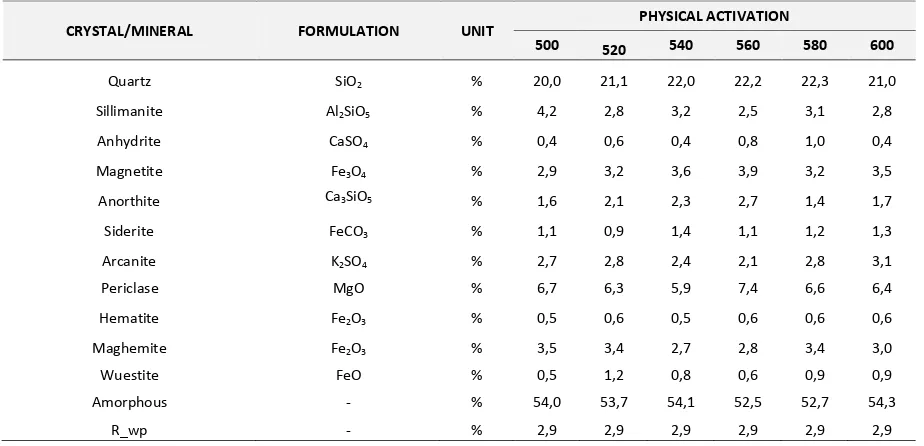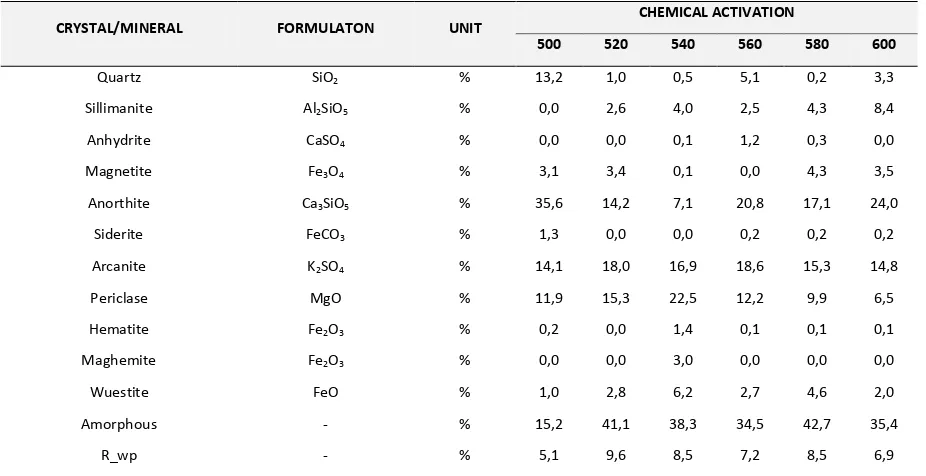Utilization of Coal Fly Ash as Co Gas Adsorbent
Ayu Lasryza, Dyah Sawitri
Department of Engineering Physics, Faculty of Industrial Technology,Institut Teknologi Sepuluh Nopember, Kampus Keputih ITS Sukolilo Surabaya 60111 INDONESIA
E-mail : [email protected]
Abstract :
This research focused on coal fly ash fabricated as CO adsorbent. Coal fly ash having grain size of 325 mesh was characterized by XRF, XRD and SEM-EDX. Physical activation was done at temperatures of 5000C, 5200C, 5400C, 5600C, 5800C and 6000C. Chemical activation was undertaken by mixing between fly ash and NaOH with mass ratio of 1: 1.2 with subsequent heating at 7500C for 1 h and followed by washing the specimens until pH=7. The samples were dried at 1000C for 1 h. The major constituents of unactivated coal fly ash are Fe, Ca, K, Si and Al in the form of quatz and anorthite. The chemical activation led to reduce the amount of quartz or increase the amount of anorthite. Physical activation does not affect the amount of minerals.
Keywords: adsorbent, activation, characterization, fly ash
1. Introduction
Coal is one of alternative energy resources. In term of price coal is cheaper than natural oil. Indonesia has a lot of coal resources, and the utilization of coal in Indonesia increases every years. It attains 14,1% from total of other energy resources. It is expected that coal usage will increase until 34,6% at 2025[1]. Utilization of coal produces waste that can contaminate environment such as CO2, NOX, CO, SO2, hydrocarbon dan solid waste. The solid waste is in the form of ash, i.e fly ash and bottom ash. According to data of Ministry of Environment in 2006, fly ash production reaches 52,2 ton per day, whereas bottom ash waste production reaches 5,8 ton per day [1].
Coal fly ash is exhaust waste was usually released to air without control. Actually fly ash waste is a kind of hazardous waste. Generally, fly ash can be temporary saved at coal power plant and further thrown in landfill. Accumulation of this coal fly ash may raise environment al problem [2]. Coal fly ash can be used for raw material of cement and construction material [2]. Another utilization of coal is as adsorbent [3]. As adsorbent, fly ash has advantage in term of economical prices and good for gas and liquid waste management [4]. Physical and chemical activation is required to allow coal fly ash for being use as adsorbent. Physical activation is done by heating at high temperature, whereas chemical activation is done by mixing of fly ash and acid liquid or alkali.
2. Material and Methods
2.1 Materials
Coal fly ash is exhaust result of kiln I process in PT. Semen Gresik. It has grain size of 325 mesh. Coal fly ash have dark brown colour. This colour depend on type of coal, too. In this research the type of coal is lignite whose quality is the lowest among other type of coals.
2.2 Methods
Two activations were used in this research, namely physical and chemical activations. The physical activation was done by heating the sample at temperatures of 500°C, 520°C, 540°C, 560°C, 580°C, and 600°C for 1 hour. Chemical activation was done by mixing fly ash and NaOH with the mass fractions of fly ash and NaOH are 1 : 1.2. The mixtures were heated at temperature of 750°C for 1 hour followed by grinding process. Then, the samples were mixed with distilled water with L/S of 1/5 in a constant stirring of 400 rpm for 30 minutes. Finally leaching was done until pH = 7, the samples were then subsequently dried at temperature of 1000C for 1 hour.
3. Result and Discussion.
3.1 Unactivated Coal Fly Ash Characterization
Table 1 shows composition in unactivated fly ash. From Table 1 it is known that the highest contents in the fly ash are Fe, Ca, K, Si and Al, and the highest oxide are Fe2O3, CaO, SiO2, Al2O3 and K2O. The important substance for adsorbent are Si and Al, while Ca is the substance that has to be remove. Ca can disturb the adsorption process
because it may lead the reaction to become unstable.
Table 1. XRF analysis of unactivated coal fly ash
No. Substance Concentrate (%) Oxide Concentration (%)
1. Al 1,8 Al2O3 2,9 mainly amorphous aluminosilicate with a less number of iron-rich part. It is likely that the iron oxide bounds with aluminosilicate to form amorphous phase. While aluminum and silicon form either as sillimanite, quartz, or binds with Ca to form anorthite. Calcium was associated with oxygen, sulfur or with silicon or aluminum. The calcium-rich material is different in elemental composition from the amorphous alumino-silicate parts. It is clearly a non-silicate mineral possibly calcite, lime, gypsum or anhydrite [5].
Table 2. XRD analysis of unactivated coal fly ash
No. Mineral Formula Konsentrasi (%)
1. Quartz SiO2 21,1
Figure 1. Result SEM of unactivation coal fly ash
3.2 Activation Coal Fly Ash Characterization
From Table 3 and 4 one can observe that amorphous phase and quartz crystalline still dominate in fly ash after physical activation. There is little changes of mineral composition after physical activation. On the other hand, the chemical activation changed the amount of minerals in fly ash. For example, after chemical activation the amount of quartz decreases while the amount of anorthite increases. Figure 2 exemplifies the change in the amount of mineral of fly ash after physical and chemical activation. From Figure 2 it is known that chemical activation plays an important in changing the amount of minerals, while the physical activation does not affect significantly.
Table 3. XRD Quantitative Data of Coal Fly Ash with Physical Activation
CRYSTAL/MINERAL FORMULATION UNIT PHYSICAL ACTIVATION
500 520 540 560 580 600
Quartz SiO2 % 20,0 21,1 22,0 22,2 22,3 21,0
Sillimanite Al2SiO5 % 4,2 2,8 3,2 2,5 3,1 2,8
Anhydrite CaSO4 % 0,4 0,6 0,4 0,8 1,0 0,4
Magnetite Fe3O4 % 2,9 3,2 3,6 3,9 3,2 3,5
Anorthite Ca3SiO5 % 1,6 2,1 2,3 2,7 1,4 1,7
Siderite FeCO3 % 1,1 0,9 1,4 1,1 1,2 1,3
Arcanite K2SO4 % 2,7 2,8 2,4 2,1 2,8 3,1
Periclase MgO % 6,7 6,3 5,9 7,4 6,6 6,4
Hematite Fe2O3 % 0,5 0,6 0,5 0,6 0,6 0,6
Maghemite Fe2O3 % 3,5 3,4 2,7 2,8 3,4 3,0
Wuestite FeO % 0,5 1,2 0,8 0,6 0,9 0,9
Amorphous - % 54,0 53,7 54,1 52,5 52,7 54,3
Table 4. XRD Quantitative Data of Coal Fly Ash with Chemical Activation
Figure 2. Comparison of quartz contents after physical and chemical activation
Physical activation causes losing water content (intercrystalline water) in fly ash as indicated by thermogravimetry experiments [6]. Whereas chemical activation may active the unactivated substances, and finally aids the adsorption process.
Acknowledgement
The authors would like to thank to DITJEN DIKTI as organizer of Program Kreativitas Mahasiswa for funding this research, Mr. Heri Purnomo, ST from PT. Semen Gresik for his assistanship in XRD analysis, Ninit Martianingsih, S.Si who helps the SEM-EDX characterization, Nurul Faradillah Said, S.Si who helps the XRF characterization.
References
[1] Setiaka, Juniawan, Ita Ulfin, Nurul Widiastuti. 2011. Adsorpsi Ion Logam Cu(ii) dalam Larutan pada Abu Dasar Batubara Menggunakan Metode Kolom. Prosiding Tugas Akhir. Jurusan Kimia, Institut Teknologi Sepuluh Nopember. Surabaya [2] Jumaeri,dkk. 2007. Preparasi dan Karakterisasi Zeolit dari Abu Layang Batubara secara Alkali Hidrotermal. Reaktor, Vol. 11
No.1, Juni 2007, Hal. : 38-44
[3] Ah aruzza a M. . A re ie o the utilizatio of fly ash. Progress i E ergy a d Co ustio S ience, 36: 327–363 [4] Mohan S, Gandhimathi R. 2009. Removal of heavy metal ions from municipal solid waste leachate using coal fly ash as an
adsorbent. Sience Direct. Journal of Hazardous Materials, 169: 351-359
[5] Barbara G, Kutcko, Ann G. Kim. 2006. Fly Ash Characterization by SEM-EDS. Fuel, 85: 2537-2544


